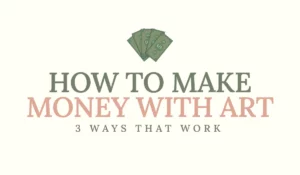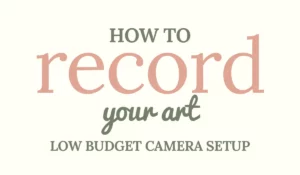You might have heard of someone named Beeple selling his digital artwork for $69 million dollars. How did he do this you might ask? By creating an NFT! But, how can you even sell digital artwork when it’s already out there, for everyone to see and save in full HD? Why would someone even want to buy something when it doesn’t give them any benefits? What is an NFT? But most importantly, what is the controversy surrounding NFT art and its moral conflicts?
Use the table of contents if you want to skip to the controversy part!
The controversy surrounding NFT art and its moral conflicts
Understanding concepts
To understand all of this we first need to understand a few concepts. I heavily simplified each term so I encourage you to do your own research to gain more information.
Glossary

Explanation
NFT stands for non-fungible token. It’s a unit of data that contains a unique digital item. This could be digital art, music, or even a digital item from a video game.
Cryptography is a process that secures data so it cannot be accessed by third parties.
A blockchain is a growing list of records that are linked using cryptography. To simplify: A blockchain is a digital ”book” in which transactions are recorded. NFTs are contained within a blockchain.
Cryptocurrency is a digital asset that was made to work like the concept of money. The records of the ownership of cryptocurrency, the transactions, are stored in a blockchain secured by cryptography.
Ethereum is a kind of blockchain (in which most NFTs are listed). It’s also the native cryptocurrency of the Ethereum blockchain.
Proof of work is a mechanism that allows a blockchain to, (among other things), agree on things like account balances and the order of transactions. It ensures that the blockchain is difficult to attack. Proof of work is based on cryptography. It is known to be incredibly energy-consuming.
Proof of stake has the same goal as proof of work, like (among other things) verifying transactions, but it differs in its approach. It is 99% less energy-consuming than proof of work.
Minting is the process of turning artwork into an NFT.
Mining is when someone accumulates cryptocurrencies by letting their computer solve difficult cryptographic puzzles.
Controversy surrounding NFT art
Okay, but now you still don’t know what’s going on. Well, let me tell you.
Digital artists are turning their artwork into NFTs because they want to make a profit. NFTs are auctioned, so the one who offers the most will get ownership of the NFT. This means that selling your NFT could result in you earning a huge amount of money.
But here’s the problem: NFTs are sold in digital marketplaces that use the cryptocurrency Ethereum. Ethereum is built on something called proof of work.

Proof of work
According to Ethereums website, one of the cons of proof of work is that it uses so much energy that it’s bad for the environment. You can see proof of work like a security system for cryptocurrencies. To make sure every transaction is validated, and to keep everything secure, proof of work makes people solve incredibly difficult mathematical equations.
These equations are so hard, and there are so many of them, only extremely powerful computers can process these. This results in incredible consumption of energy. So bad that it’s hurting the environment. To give you an idea: the yearly cost of Ethereum is equal to the yearly energy consumption of Ireland.

Moral conflicts surrounding NFT art
However, Ethereum states that validation cycles consume energy at a rate that is largely independent of the level of NFT activity. Indeed, NFTs themselves are not the cause of immense energy consumption. It’s the proof of work algorithm that’s harmful.
That raises the question and thus controversy: Are digital artists responsible for contributing to the enormous energy consumption when not the NFT itself, but the way it’s processed is bad for the environment?

Does it matter the greyed-out people did not buy a ticket?
The bottom line is if more and more people will make NFTs the more energy consumption there will be.
Alternatives
Ethereum is looking at different options to reduce its carbon footprint. Proof of stake, which is a lot less harmful to the environment, would be a solution. They have been saying for years they will switch to proof of stake. Unfortunately, this doesn’t seem to be realistic in the near future so the big energy consumption continues.
Buying an NFT does not gain the buyer anything other than.. bragging rights. Other people are able to copy and download digital artwork without anyone stopping them. This is why the selling of NFTs is considered to be more of an elitist way. It’s about being the owner of something unique. So why not take matters into your own hands and avoid NFTs altogether?
If someone is spending millions on a piece of artwork they will most likely meet the artist in person anyway. Buy directly from a digital artist, not through NFTs.
How does the (digital) art community feel about NFT art?
It seems like most digital artists are strongly against the use of NFTs. But a handful of already successful artists do use them. Why? Money. There’s a chance that their artwork will sell for an amount that will set them for life. But this is only a possibility, not a given. If every artist would think in the same way, more and more would make an NFT resulting in an increase in energy consumption.
Of course, I’d love to have a chance to sell artwork that will set me for life. But not at the cost of the already damaged environment. I think most artists realize they won’t earn millions of dollars with their NFTs. But then making an NFT just to earn a few hundred bucks would be even worse, right?

Unfortunately, I had to unfollow a lot of artists who I admired because, as some of the comments on their posts say, they choose the dark side. There’s nothing that keeps them from selling their work on their own platform or an auctioning that doesn’t consume so much energy. Out of the 305 comments on an artist’s Instagram, I saw less than 5 comments that actually supported the artist when they announced their NFTs. The other comments were convincing her to not use NFTs. Unsurprisingly she only replied to the supportive comments.
So what about you? Would you create something that gives you a chance to be set for life knowing it’s extremely harmful to the environment?
Until next time,
♡ Laura




